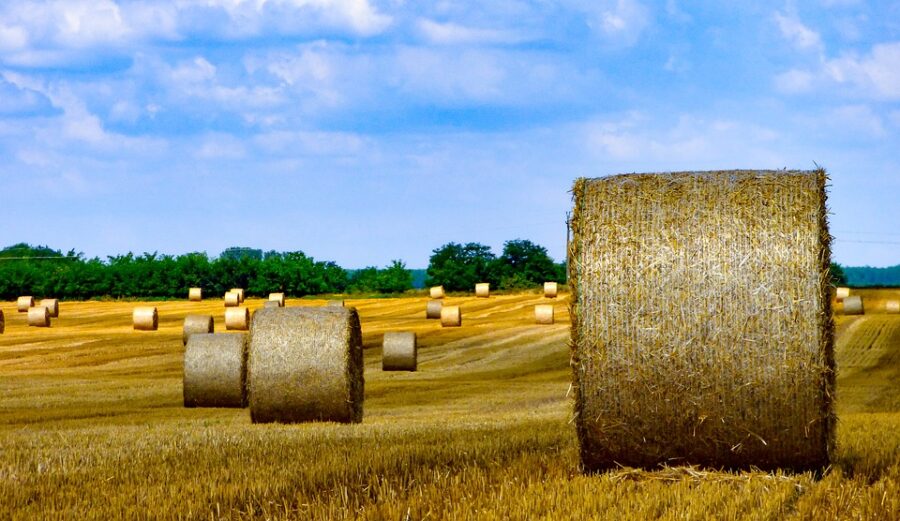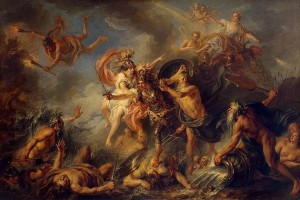Even in the midst of the industrustrialization of England during the 19th century, poet and priest Gerard Manley Hopkins insists upon the sustaining and revealing presence of Christ in the physical world. In his Petrarchan sonnet, “Hurrahing in Harvest,” the poet, reflecting upon the late summer fields ripe with abundance, encounters Christ whose presence stirs the soul and propels the speaker into communion and union with God. The poem seeks to represent this space as one of irresistible movement, increasing acceleration, and ascent through a host of poetic devices in order to draw the reader into participation with the speaker. In other words, the poem testifies to how the space initiates and directs the movement of the viewer’s soul while also serving as the site for the reader’s own ascension.
The poem opens with the speaker’s description of the surrounding landscape detailing the beauty which he beholds, marveling at the fields and sky:
SUMMER ends now; now, barbarous in beauty, the stooks arise
Around; up above, what wind-walks! what lovely behaviour
Of silk-sack clouds! has wilder, wilful-wavier
Meal-drift moulded ever and melted across skies? (lines 1-4)
From the beginning, Hopkins works to characterize this experience of the harvested fields as distinctive, set apart from the conventional expectations of perception. By employing the word “barbarous” in the first line to describe the bundles of harvested grain, the poet immediately reorients the reader’s perception. These “stooks” of gathered grain, rather than representing a familiar orderliness, possess a certain kind of uncultivated and uncivilized beauty. The “barbarous” beauty not only adjusts the reader’s perception, but also suggests a strangeness or otherness present within the otherwise familiar scene. The discovery of these unknown depths of reality opens up onto the speaker’s praises of wonder at the clouds smeared across the sky, “what wind-walks!” The remainder of the stanza is dedicated to the speaker’s description of the clouds, a description dominated by alliteration and punctuated with compounded words (“wind-walks,” “silk-sack,” “wilful-wavier,” and “meal-drift”). Ribboning words together, stacking words upon words, the poet struggles to capture the singular beauty of the sky placing the reader in a similar state of bewilderment. The combined forces of alliteration and compounded words expand the spirit of wonder from the stooks to the sky as well as build a rhythmic momentum, an upward energy which will ultimately culminate in flight. To emphasize once again the speaker’s state of marvel, the poet concludes the first stanza with a question: “has wilder, wilful-wavier/ Meal-drift moulded ever and melted across skies?” The singularity of the sky’s beauty indicated by the speaker’s question reinforces the sense of the remarkable otherness implied throughout the first lines and presses deeper into the mystery of its “barbarous” beauty.
The second stanza begins by returning to the pattern of upward movement portrayed in the first stanza. With words echoing the Psalms of Ascent, the poet introduces the corresponding inner movement of the heart saying “I walk, I lift up, I lift up heart, eyes” (line 5). Again, the use of repetition works to build a sense of climbing movement. The following line, beginning with “Down all that glory in the heavens,” drops with a sweeping motion, gathering up the whole scene (line 6). From this grand view, the speaker looks “to glean our Saviour” (line 6). Borrowing the vocabulary of the surrounding agrarian landscape, the poet identifies his encounter with Christ through the language of the landscape. In other words, not only is the Saviour present within this place, but the place itself offers a language of understanding Christ’s presence. The speaker continues:
And éyes, heárt, what looks, what lips yet gave you a
Rapturous love’s greeting of realer, of rounder replies? (lines 7-8)
Turning once again to address the eyes and heart, the poet poses a second rhetorical question, a question designed– like the first– to assert the incomparability of the “Rapturous love’s greeting.” Though these lines clearly address the relationship between Christ and the speaker, the “you” who receives “love’s greeting of realer, of rounder replies” remains ambiguous (line 8). There are two possibilities: the “you” may refer to the speaker or the Saviour. In the first case, the speaker receives the loving reply of Christ to the praises of wonder proclaimed– “what wind-walks! what lovely behaviour/ Of silk-sack clouds!” If the “you,” however, refers to Christ, then it is the speaker who is responding with “looks” and “lips” of love to the initiating presence of the Saviour. In either case, these lines depict the intimate meeting between Christ and the speaker. The ambiguity of who gives and who receives, who instigates and who responds creates a space of ongoing communication and communion between God and the poet. Furthermore, the reader, through the process of discerning the pronoun’s identity, is invited into this relational space. Just as the first stanza develops a sense of ascent through the directional cues in the poetic narrative and the use of compounded and alliterative language, the second stanza continues to advance this upward drive, extending beyond the physical movement of the speaker’s eyes to their spiritual orientation and experience.
While the second stanza introduces the reader to the idea of Christ being in and through the physical world, the third stanza begins by asserting a indivisible unity between the physical world and the divine presence. The poet sings, “And the azurous hung hills are his world-wielding shoulder/ Majestic– as a stallion stalwart, very-violet-sweet!–” (lines 9-10). The topological forms of the world are the shape of Christ; the holy presence of God is necessarily united to the world created by and through Him. Though the poet has spoken of this scene as one of unique and particular beauty, the poet also insists that Christ’s presence permeates all creation. In the final lines of the poem, the speaker reflects upon the condition of the soul and the transformation that occurs once the soul sees truly.
These things, these things were here and but the beholder
Wanting; which two when they once meet,
The heart rears wings bold and bolder
And hurls for him, O half hurls earth for him off under his feet. (lines 11-14)
Though the repetition employed earlier in the poem has worked to generating a climbing effect, the repetition of “these things” momentarily slows the pace producing a reflective tone signaling the reader to prepare to note the poet’s contemplative realization. It is true that “these things were here,” but the poet adds a condition, “but the beholder/ Wanting.” Although the conjunctions “and but” complicate the clarity of this phrase, the poet seems to claim that the divine presence is available to those who do not lack what is needed to see. But what is needed? Hopkins does not answer this question directly, but his use of the word “wanting” might offer a clue. “Wanting” also conveys desire or longing in addition to implying a deficiency; perhaps the poet is suggesting that those who desire Christ will see Him and those without a desire for the divine will not perceive His presence. The poet then considers the transformation which occurs in the soul “when they once meet.” Summarizing the encounter between the Saviour and the beholder the speaker draws upon Plato’s Phaedrus in which Socrates compares the soul to a chariot led by two winged horses. According to Socrates, the soul was made to soar in the heavens contemplating the divine truths, but instead has fallen into flesh brought down by unruly appetites. The soul, in other words, loses its wings. Socrates argues that the soul may yet regrow wings and ascend through encounters with the shimmerings of heavenly truth found throughout the world. Hopkins borrows this narrative of ascent in these final lines: the “heart rears wings” and grows incrementally stronger– “bold and bolder”– until the soul possesses the strength to race toward him with vigor and force. The galloping rhythm of the final line “And hurls for him, O half hurls earth for him off under his feet” not only concludes the narrative of ascent with flight but embodies this movement sonically thus drawing the reader up into the movement of the speaker.
Hopkins’ “Hurrahing in Harvest” not only works to relate the soul’s experience of meeting the Saviour in the world, but also imitates the movement of ascent through the language and syntax of the poem to create a participatory space for the reader. In following the speaker’s own lifting up of eyes and heart, the reader is graced with the eyes to see the presence of Christ and propelled forward into a new perception of the world in all its commonness and miraculous grandeur.





Leave a Reply
Your email is safe with us.